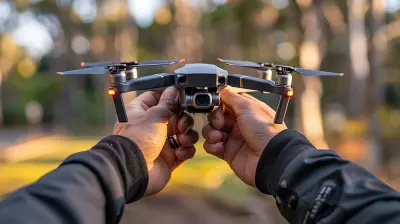The Intersection of 5G and Cybersecurity
16 July 2025
Welcome to the digital fast lane! With 5G rolling out like wildfire, we’re not just getting a speed upgrade—we're entering an entirely new realm of hyper-connectivity. But here’s the kicker: while 5G promises to revolutionize how we work, play, and communicate, it also opens up a whole new can of worms in the realm of cybersecurity.
In this article, we’re diving headfirst into the thrilling—and sometimes terrifying—crossroads where 5G and cybersecurity meet. Buckle up.
What’s All the Fuss About 5G Anyway?
Before we dig into cybersecurity threats and defenses, let’s first get clear on what 5G is.5G stands for “fifth-generation mobile network.” It’s the latest evolution of wireless technology, and it’s blazing fast. We're talking up to 100 times faster than 4G. But it’s not just about speed. 5G also offers:
- Ultra-low latency (near real-time responsiveness)
- Massive device connectivity (think IoT on steroids)
- Increased bandwidth and reliability
Sounds amazing, right? But like any major tech upgrade, it doesn’t come without its own baggage.
Why 5G Is a Double-Edged Sword
Imagine giving everyone a Ferrari and telling them to drive on a road with no speed limits and few traffic signs. That’s kind of what 5G is doing digitally. It's enabling mind-blowing possibilities—remote surgery, autonomous cars, smart cities—but it’s also creating a much bigger target for cyber criminals.More Devices, More Entry Points
5G’s ability to connect billions of devices simultaneously is pretty epic, but more connected devices mean more doors for hackers to sneak in. Your smart fridge? Yep—hackable. Your smartwatch? Also on the list.Decentralized Infrastructure = Decentralized Risk
Unlike 4G networks which had centralized hardware, 5G relies heavily on software-based systems and edge computing. That means the attack surface is spread out and harder to secure. It’s like trying to guard a fortress that keeps shapeshifting.
Top Cybersecurity Concerns in the 5G Era
Let’s face it—where there’s data, there’s danger. And 5G brings a tsunami of data.1. Supply Chain Attacks
Building a 5G network involves a web of vendors, suppliers, and service providers. If just one of those links is compromised, the entire chain is vulnerable. Remember the SolarWinds attack? That kind of thing could become more frequent.2. IoT Vulnerabilities
With 5G empowering the Internet of Things (IoT), you’ll find connected devices in every room of your home, car, and office. The problem? Many of these devices come with weak security protocols—default passwords, outdated firmware, etc. Hackers love that.3. Nation-State Threats
5G plays a critical role in national infrastructure, from power grids to emergency services. That makes it a juicy target for cyber warfare. Countries are growing increasingly wary of foreign tech vendors for this very reason.4. SIM Jacking and Spoofing
Because 5G still relies on mobile networks, attackers can exploit SIM vulnerabilities. Techniques like SIM swapping allow bad actors to hijack your phone number and gain access to sensitive accounts—banking, social media, and even corporate logins.
How 5G Changes the Cybersecurity Game
So, how does this all shift the cybersecurity landscape? Let's break it down.Zero Trust Becomes More Than a Buzzword
In a 5G world, the "castle-and-moat" approach to security is toast. With decentralized systems and millions of edge devices, companies need to adopt a “zero trust” model—assume nothing and verify everything.AI and Automation Step Up
Manual monitoring won’t cut it anymore. The network is too fast, too vast, and too complex. AI-driven threat detection and automated response systems are becoming non-negotiable.Security by Design
In the past, security was often slapped on after a system was designed—like a Band-Aid. With 5G, there's a shift toward building cybersecurity into the DNA of products and networks right from the get-go.Building a Defense Strategy in the 5G Era
Alright, enough doom and gloom. What can we actually do to stay safe in this brave new world?1. Harden the Network Core
The core of a 5G network is like its beating heart. If it gets compromised, everything else goes down. Telcos need to focus on robust encryption, secure slicing (more on this in a sec), and frequent audits.2. Secure Network Slicing
One of the coolest bits of 5G is "network slicing"—basically creating multiple virtual networks on top of a single physical one. It’s like having customized lanes on a superhighway just for specific types of traffic.But guess what? Each slice can be a potential attack vector. So, each needs its own tailored security measures.
3. Fortify the Edge
With edge computing becoming more common (processing data closer to where it's generated), edge nodes need heavy-duty protection. Firewalls, intrusion detection, and patch management are key.4. Educate the Masses
Cybersecurity isn’t just an IT problem—it’s a human one. Users need to be aware of phishing attacks, suspicious links, and data hygiene. Think of it as digital hygiene, like washing your hands but for your online life.The Role of Governments and Regulations
Governments aren’t just sitting on the sidelines either. Regulatory bodies around the world are stepping up.GDPR and CCPA
These aren’t just acronyms to fog your brain. Privacy laws like the General Data Protection Regulation (GDPR) and California Consumer Privacy Act (CCPA) are laying down rules to ensure companies handle user data responsibly, especially over high-speed networks.Bans on Foreign Vendors
Ongoing geopolitical concerns have led to bans on certain vendors in critical network infrastructure. Countries are creating “trusted vendor” lists to help mitigate nation-state-level cyber threats.What Does This Mean for Businesses?
If you're running a business—big or small—it's time to start thinking 5G-first. Here’s what to do:- Audit your devices: Know what’s connected to your network.
- Update your policies: Make sure your cybersecurity policies reflect a 5G world.
- Invest in tech: AI-driven cybersecurity tools and cloud-native defenses are your new BFFs.
- Work with trusted partners: Vet your vendors like your business depends on it—because it does.
The Future Is Fast—But It Needs to Be Safe
Let’s not forget, 5G is still in its infancy. We’re only beginning to scratch the surface. As the infrastructure matures, so too will the threats—and the solutions.Potential for Quantum-Safe Encryption
Not to get too sci-fi, but quantum computing is on the horizon. It could either break all current encryption... or lead to uncrackable security. Either way, it’s something cybersecurity experts are watching very closely.Blockchain-Based Security
Yep, blockchain isn’t just for crypto bros. Distributed ledger technology might be used to authenticate devices, transactions, and even verify identities across 5G networks.Final Thoughts
The intersection of 5G and cybersecurity is like speeding down a digital Autobahn—exhilarating, but dangerous if you’re not paying attention. We’re unlocking new possibilities in tech, medicine, business, and entertainment. But we’re also unlocking Pandora’s box of vulnerabilities.The key is balance. We can’t afford to slow down, but we also can’t rely on duct tape solutions. Whether you're a tech enthusiast, a business owner, or just someone who loves your smart gadgets, 5G is going to touch your life. Better to be ready than sorry.
So go ahead—embrace the speed, but keep your digital seatbelt fastened.
all images in this post were generated using AI tools
Category:
5g TechnologyAuthor:

Adeline Taylor
Discussion
rate this article
2 comments
Kristen McGillivray
This article highlights the critical balance between the rapid deployment of 5G technology and the increasing need for robust cybersecurity measures. As our reliance on connected devices grows, understanding the vulnerabilities and implementing strong security protocols will be essential to safeguarding our digital future. Great insights!
December 18, 2025 at 3:42 AM
Hope Underwood
5G: Fast internet, faster hackers—hold onto your hats!
August 5, 2025 at 3:40 AM

Adeline Taylor
Absolutely! While 5G offers incredible speed and connectivity, it also presents new challenges for cybersecurity. It's crucial to stay vigilant and enhance our defenses as technology evolves.


